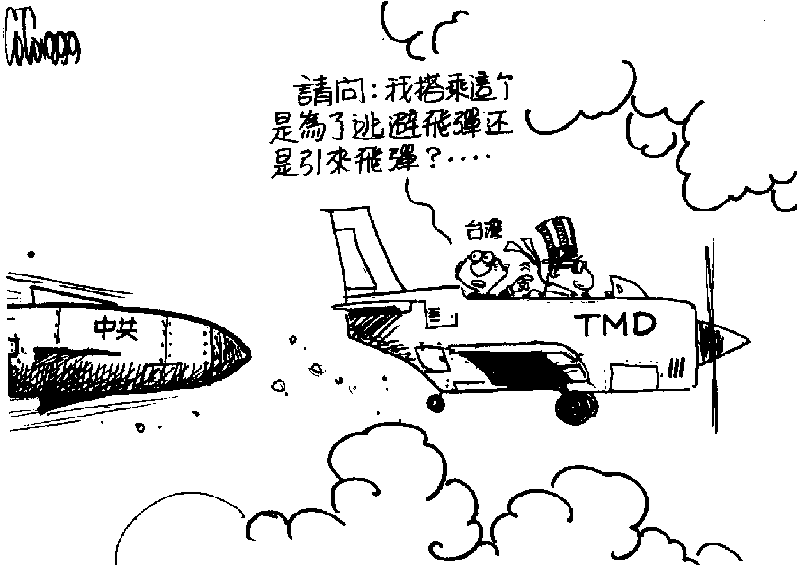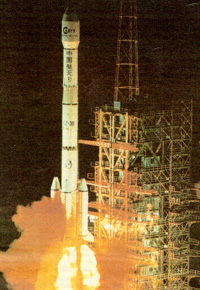 Taiwan
Communiqué No. 85, March 1999
Taiwan
Communiqué No. 85, March 1999 Taiwan
Communiqué No. 85, March 1999
Taiwan
Communiqué No. 85, March 1999At the beginning of February 1999, major British and American newspapers reported a significant increase in China's missile threat to Taiwan, up from 30-50 missiles during the March 1996 crisis, to 150-200 missiles at present. It is essential that the United States and other Western nations take a firm stance in opposition against China's campaign of threats and intimidation against Taiwan.
 |
|
Taiwan to "pilot" USA: "Are we avoiding the missile, or is it catching up with us?" |
The White House and State Department now seem to be downplaying the increase, saying it is "not a new threat". This is highly peculiar: if Mr. Clinton has known about this more than tripling of the number of missiles, why has he been silent on it, and has he not confronted the aggressors like President Kennedy did with the Cuban missiles in 1962? In fact, Mr. Kennedy faced only 16 to 32 deployed Russian missiles in Cuba, while the present reports refer to 150-200 Chinese missiles -- of much higher accuracy -- facing Taiwan now, and some 650 foreseen by the year 2005.
China's present missile buildup is in particular designed to try prevent
the United States from incorporating Taiwan under the defensive shield of
the proposed East Asian Theater Missile Defense system. The United States
should maintain the position that Taiwan has the right to be an integral
part under this system.
China threatens that bringing Taiwan under the TMD-umbrella will increase tension in East Asia. To the contrary: providing Taiwan with a defensive shield will be a major factor in bringing about stability and peace in East Asia. Eventually, it will bring the Chinese leaders to the realization that they cannot force a free and democratic Taiwan to unify, and that they should accept Taiwan as a friendly and independent neighbor and establish diplomatic ties with this new neighbor.
Taiwan is a free nation, which only recently achieved a democratic political system, thanks to the hard work of its democratic movement. This new nation deserves to be accepted by the international community as a full and equal member. The West, and in particular the United States, should not let itself be intimidated by China's temper tantrums. It should stand up for the basic principles of democracy, human rights, and self-determination as enshrined in the UN Charter.
On the following pages we briefly summarize a number of recent reports related to China's military buildup, and to the balance across the Taiwan Strait.
On 26 January 1999, the Washington Times published an article by its reporter Bill Gertz, indicating that according to Pentagon officials, China's army conducted military exercises with simulated missile firings against Taiwan and also for the first time conducted mock attacks on U.S. troops in the region, according to Pentagon intelligence officials.
The exercise began in late November and ended in early December 1998 as road-mobile CSS-5 medium-range missiles maneuvered along China's coast, said officials familiar with a December 2nd, 1998 Defense Intelligence Agency report on the exercise.
Disclosure of the Chinese exercise came as officials in the Clinton administration said efforts are under way to soften the conclusions of a congressionally mandated report on missile defenses and missile threats in Asia, including new details on the rapidly growing Chinese missile arsenal.
The Washington Times article reported that according to sensitive intelligence gathered by U.S. satellites, aircraft and ships that monitored the Chinese exercise, People's Liberation Army units, including those equipped with intermediate-range CSS-5s and silo-housed CSS-2 missile units practiced firing missiles at Taiwan.
The intelligence information also indicated that the U.S. Army troops based in South Korea, and Marine Corps troops on the Japanese island of Okinawa and mainland Japan were targeted with strikes. "They were doing mock missile attacks on our troops," said one official.
A senior administration official confirmed that the missiles were CSS-2s, first deployed in 1971, and CSS-5s, first fielded in the 1980s. Both weapons had "never been pointed our way before," the senior official said. "The important point is these are not new missiles."
The Washington Times stated that the intelligence report also raises questions about the recent statement of Chinese President Jiang Zemin, who announced during the June 1998 summit in Beijing that he and President Clinton agreed "we will not target each other with the strategic nuclear arms under our control."
The Washington Times also stated that according to an earlier Pentagon intelligence report, China is engaged in a major program to upgrade its 40 CSS-2s with newer and more capable CSS-5s, which come in two versions. Liquid-fueled CSS-2s, with ranges of about 1,922 miles, are being replaced in some regions by solid-propellent CSS-5s that have a maximum range of 1,333 miles, the 1996 report said.
 On 31 December 1998, a select committee of the US House of Representatives
concluded that US national security interests were damaged when two US
aerospace companies, Hughes and Loral Space and Communications, provided
China with technical information after the failure of two Chinese Long
March rockets carrying American-built satellites.
On 31 December 1998, a select committee of the US House of Representatives
concluded that US national security interests were damaged when two US
aerospace companies, Hughes and Loral Space and Communications, provided
China with technical information after the failure of two Chinese Long
March rockets carrying American-built satellites.
Both the New York Times and the Washington Post reported on 31 December 1998 that the committee, headed by Congressman Christopher Cox (R-CA), had unanimously approved a still-secret 700-page report, which also concluded that over the past 20 years, China had been involved in a serious and sustained effort to steal the most sensitive of American military technology, including nuclear weapons designs and high-performance computers.
The Cox-committee, which was established in mid-1998 after the Loral and Hughes affairs came to light earlier during the year, made 38 recommendations for legislative and executive orders in areas such as tightening control over the export of sensitive technology, access to US national laboratories, and the handling of sensitive intelligence data.
On 10 February 1999, the London-based Financial Times reported that China has sharply increased its deployment of missiles aimed at Taiwan. The move means yet another increase in tension in the region.
The newspaper cited military analysts in Washington who had access to a classified Pentagon report, which stated that the Chinese had stationed 150 to 200 M-9 and M-11 missiles in its southern regions aimed at Taiwan. The Financial Times quoted a senior U.S. administration official as warning that China "couldn't assume that a continued missile build-up in Southeast Asia will go unanswered."
The newspaper said that the reported escalation, coming before a planned visit to Washington in the spring by Chinese Premier Zhu Rongji, was emerging as a serious foreign policy headache for the Clinton administration. It reported that it was "...causing sharp differences within the U.S. government over an appropriate response," adding that the Department of Defense was said to favor a stronger show of support for Taiwan, but the State Department and National Security Council feared risks to Washington's growing "co-operative strategic partnership" with Beijing.
According to the report, China had 30 to 50 short-range ballistic missiles in its southern areas in 1995-96 when it launched the M-9 missiles into waters off Taiwan, prompting President Clinton to send two aircraft carrier task groups to the area.
The Financial Times reported that a Pentagon study in October 1998 concluded that China was pouring resources into missile development to improve its ability to prevail in a local conflict on its south-eastern flank "especially in the Taiwan Strait and South China Sea."
In Mid-February 1999, the US Defense Department issued a report to Congress, examining the possible components for regional missile defenses in Asia that would have the capability of protecting key regional allies, Japan, South Korea, and Taiwan from missile attack.
It was mandated by the fiscal 1999 defense authorization bill and includes descriptions of U.S. missile defenses that could be transferred to key allies in Asia for "self-defense against limited ballistic missile attacks," according to the legislation requiring it. The plan was initiated after the unexpected launching of a missile by North Korea in the beginning of September 1998, but is also prompted by concerns about China's increasing missile threat.
The report was originally due to reach Congress on 1 January 1999, but the Pentagon has been held up from sending the report to the House Armed Services Committee because of disagreements with its conclusions. According to press reports, the White House and State Department's East Asia bureau are said to be seeking to water down some of the harsh conclusions of the report, while the Pentagon and CIA want it to present unvarnished views of the Chinese missile threat.
According to officials familiar with the report, the Pentagon study shows that China is engaged in a major strategic missile buildup of several types of weapons that political officials are reluctant to publicize for fear of upsetting the Chinese government. China's government is opposed to deployment of U.S. missile defenses in Asia because they could counter Chinese missiles.
A separate report on the military balance in the Taiwan Strait, which was originally due in Congress on 1 February 1999, has not been published yet. The directive for this study was also contained in the 1999 Defense authorization bill, and was initiated by Senator Frank Murkowski (R-Alaska).
Mr. Murkowski and others who supported the initiative stated they wanted more than the traditional "force-on-force analysis." He stated that rather than merely counting troops and equipment, the Pentagon should evaluate the capability of China's PLA "...to conduct command and control warfare against Taiwan, including .... information dominance, air superiority, naval blockade and amphibious invasion. This is an area that has not received enough attention in terms of evaluating Taiwan's defensive capabilities."
A co-sponsor of the initiative, Senator Ted Stevens, also of Alaska, emphasized that the 1979 Taiwan Relations Act (TRA) envisions that Congress remain "...fully and currently informed on the military balance in the tense Taiwan Strait."
The Taiwan Relations Act also stipulated that "... the United States will make available to Taiwan such defense articles and defense services in such quantity as may be necessary to enable Taiwan to maintain a sufficient self-defense capability" (Sec.3.a), and directed the President "... to inform the Congress promptly of any threat to the security or the social or economic system of the people on Taiwan and any danger to the interests of the United States arising therefrom" (Sec. 3.c. -- emphasis added).
Another co-sponsor of the initiative, Senator Daniel Inouye (D-Hawaii) added that it is "...particularly important to focus on the qualitative balance now ... as compared to what existed in 1979."
One indication of the increasing U.S. concern about the Chinese military buildup in the Taiwan Strait came on 3 February 1999, when US Central Intelligence Agency director George Tenet testified before Congress that China is developing and acquiring air and naval systems "...intended to deter the United States from involvement in Taiwan and to extend China's fighting capabilities beyond its coastline..."
Back to: Table of Contents
Copyright © 1999 Taiwan Communiqué